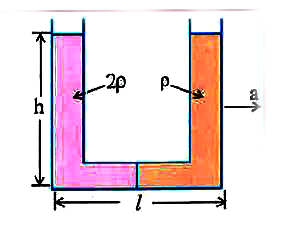A body of mass 2kg lying on ice which given a velocity of 6ms−1 is stopped by friction is 5sec find the co-efficient of friction between block and ice (g=10ms−2)Solution in Telugu
0.12
0.18
0.25
0.34
The correct Answer is:A
Step by step video, text & image solution for A body of mass 2kg lying on ice which given a velocity of 6ms^(-1) is stopped by friction is 5sec find the co-efficient of friction between block and ice (g = 10ms^(-2)) by Physics experts to help you in doubts & scoring excellent marks in Class 11 exams.
Topper's Solved these Questions
- BOOK - AAKASH SERIESCHAPTER - FRICTION EXERCISE - PRACTICE SHEET (EXERCISE-I) (LEVEL-II) (STRAIGHT OBJECTIVE TYPE QUESTIONS)6videos
FRICTION
- BOOK - AAKASH SERIESCHAPTER - FRICTION EXERCISE - PRACTICE SHEET (EXERCISE-I) (LEVEL-II) (INTEGER TYPE QUESTIONS)4videos
FRICTION
- BOOK - AAKASH SERIESCHAPTER - FRICTION EXERCISE - LECTURE SHEET EXERCISE- IV (INTEGER TYPE QUESTIONS)1videos
FRICTION
- BOOK - AAKASH SERIESCHAPTER - FLUID MECHANICSEXERCISE - Questions for Descriptive Answers14videos
FLUID MECHANICS
- BOOK - AAKASH SERIESCHAPTER - GAUSS.S LAW EXERCISE - PROBLEMS (LEVEL - II)12videos
GAUSS.S LAW
Similar Questions
Two bodies having the same mass 5kg each have different surface areas 20m2 and 10m2 in contact with a horizontal plane. If the coefficient of friction is 0.4, the forces of friction that come into play when they are in motion will be in the ratio
03:22View SolutionHalf of the chain is lying on a table. The rest of the chain hangs in equilibrium from both of the ends of the table. Extra length of the hanging chain at one end is 1/8 th of the total length of the chain than that hanging at the other end. The coefficient of friction between table and chain is 25×10−4 the value of x is
04:29View SolutionIn the figure, m1m2=1kg, The co-efficients of friction between A, B and B, surface are 0.2. The maximum value of m, so that no block slips is nx7 the value of n is (All the pullies are ideal and strings are massless).
 View Solution
View SolutionA U-tube of base length I filled with same volume of two liquids of densities ρ and 2ρ is moving with an acceleration a on the horizontal plane. If the height difference between the two surfaces (open to atmosphere)becomes zero,then find height h
 01:54View Solution
01:54View SolutionA charge q is placed at the centre of the open end of a cyclindrical vessel. Find the flux of the electric through the surface of the vessel.
02:48View SolutionA marble block of mass 2 kg lying on ice when given a velocity of 6m/s is stopped by friction in 10s. Then the coefficient of friction is
02:54View SolutionA person of mass 72kg sitting on ice pushes a block of mass of 30kg on ice horizontally with a speed of 12ms−1.The coefficient of friction between the man and ice and between block and ice is 0.02.If g=10ms−1,the distance between man and the block, when they come to rest is
04:49View SolutionA marble block of mass 2 kg lying on ice when given a velocity of 6ms^(-1) is stopped by friction in 10 s. Then the coefficient of friction is (g = 10ms^(-2))
View SolutionA marble block of mass 2 kg lying on ice when given a velocity of 6m/s is stopped by friction in 10 s. Then the coefficient of friction is:
View SolutionA block of mass m slides down the plane inclined at an angle 60∘ with an acceleration g/2. Find the co-efficient of kinetic friction.
04:49View SolutionA marble block of mass 2 kg lying on ice when given a velocity of 6ms−1 is stopped by friction in 10s. Then the coefficient of friction is (g = 10ms−2)
View SolutionA person of mass 72 kg sitting on ice pushes a block of mass of 30kg on ice horizontally with a speed of 12ms1 . The coefficient of friction between the man and ice and between block and ice in 0.02. If g=10ms2, the distances between man and the block, when they come to rest is
View SolutionA marble block of mass 2 kg lying on ice when given a velocity of 6 ms^(-1) is stopped by friction in 10 s. Then the coefficient of friction is (g = 10 ms^(-2))
03:24View SolutionA block of mass 2kg lying on ice when given a velocity of 6ms−1 is stopped by friction in 5s. The coefficient of friction between the block and ice is (g=10 ms−2)
04:44View SolutionA person of mass 72 kg sitting on ice pushes a block of mass of 30kg on ice horizontally with a speed of 12ms1 . The coefficient of friction between the man and ice and between block and ice in 0.02. If g=10ms−2, the distances between man and the block, when they come to rest is
02:51View Solution

